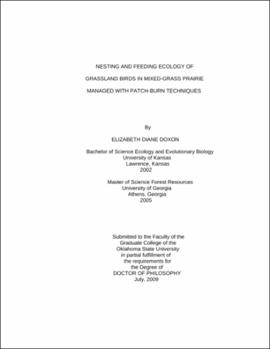| dc.contributor.advisor | Davis, Craig A. | |
| dc.contributor.author | Doxon, Elizabeth Diane | |
| dc.date.accessioned | 2013-11-26T08:26:09Z | |
| dc.date.available | 2013-11-26T08:26:09Z | |
| dc.date.issued | 2009-07 | |
| dc.identifier.uri | https://hdl.handle.net/11244/6845 | |
| dc.description.abstract | Scope and Method of Study: In 2006-2008, we applied patch-burn management techniques to a sandsage (Artemisia filifolia) mixed-grass prairie in western Oklahoma and compared the responses to traditionally managed (i.e., grazed only) pastures. We subsequently examined avian and invertebrate densities among patches of varying time since burn and level of grazing intensity. For Cassin's sparrow (Aimophila cassinii), field sparrow (Spizella pusilla), and lark sparrow (Chondestes grammacus), we conducted an intensive examination of their interactions with invertebrates including diet, foraging behavior, and stress hormone levels. | |
| dc.description.abstract | Findings and Conclusions: | |
| dc.description.abstract | Over 70% of the invertebrates increased in abundance in treatments compared to traditional patches. Lark sparrow, mourning dove, and northern mockingbird responded positively to treatments. Western meadowlark and northern bobwhite responded positively to traditional management. Eastern red cedar (Juniperus virginiana) had a stronger influence on grassland obligate avian species than grassland facultative species. We documented positive, neutral, and negative responses of nest success to patch-burn management. Lark sparrows had higher nest success in patch-burn treatments, Cassin's sparrows had similar nest success between treatments, and field sparrow had higher nest success in traditionally managed pastures. Clutch size, fledgling numbers, and cowbird parasitism were similar among treatments. The invertebrate component of the diet of the three target species varied among years and was dominated by Acrididae and to a lesser extent Lepidoptera larvae, Cercopidae, and miscellaneous Coleoptera. Lark sparrow yolk corticosterone (CORT) varied among treatments, and was generally higher in traditional patches. CORT levels were best explained by variability of invertebrate biomass, year, and egg age. Inverebrate crude protein varied among orders; Orthoptera and Araneae had the highest protein levels. Protein levels in Acrididae, Tettigonidae, Coleoptera, and Homoptera varied by time since burn but were higher in older patches. We conclude that heterogeneity-based management can be used to positively benefit grassland birds and invertebrates. | |
| dc.format | application/pdf | |
| dc.language | en_US | |
| dc.rights | Copyright is held by the author who has granted the Oklahoma State University Library the non-exclusive right to share this material in its institutional repository. Contact Digital Library Services at lib-dls@okstate.edu or 405-744-9161 for the permission policy on the use, reproduction or distribution of this material. | |
| dc.title | Nesting and feeding ecology of grassland birds in mixed-grass prairie managed with patch-burn techniques | |
| dc.contributor.committeeMember | Fuhlendorf, Samuel D. | |
| dc.contributor.committeeMember | Leslie, David L., Jr. | |
| dc.contributor.committeeMember | Lovern, Matthew B. | |
| dc.contributor.committeeMember | Joern, Anthony | |
| osu.filename | Doxon_okstate_0664D_10457.pdf | |
| osu.accesstype | Open Access | |
| dc.type.genre | Dissertation | |
| dc.type.material | Text | |
| dc.subject.keywords | fire | |
| dc.subject.keywords | invertebrates | |
| dc.subject.keywords | pyric herbivory | |
| dc.subject.keywords | sand sagebrush | |
| dc.subject.keywords | shrubland birds | |
| dc.subject.keywords | stress hormones | |
| thesis.degree.discipline | Natural Resource Ecology and Management | |
| thesis.degree.grantor | Oklahoma State University | |
